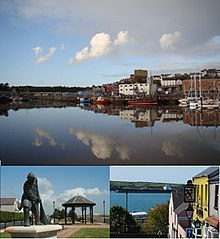
Back ميلفورد هافن Arabic ميلفورد هافن ARZ Aberdaugleddau AST Милфорд Хейвън Bulgarian Aberdaugleddau Breton Aberdaugleddau Catalan Milford Haven (lungsod) CEB Milford Haven Czech Aberdaugleddau Welsh Milford Haven Danish
Milford Haven
| |
|---|---|
 Clockwise from top: Milford Haven Docks from Hakin; Haven from town; the Tribute to Fishermen on The Rath. | |
Location within Pembrokeshire | |
| Population | 13,907 (Community 2011)[1] |
| Demonym | Milfordian |
| OS grid reference | SM899061 |
| Community |
|
| Principal area | |
| Preserved county | |
| Country | Wales |
| Sovereign state | United Kingdom |
| Post town | MILFORD HAVEN |
| Postcode district | SA73 |
| Dialling code | 01646 |
| Police | Dyfed-Powys |
| Fire | Mid and West Wales |
| Ambulance | Welsh |
| UK Parliament | |
| Senedd Cymru – Welsh Parliament | |
Milford Haven (Welsh: Aberdaugleddau, lit. 'mouth of the two rivers Cleddau' ⓘ) is both a town and a community in Pembrokeshire, Wales. It is on the north side of the Milford Haven Waterway, an estuary forming a natural harbour that has been used as a port since the Middle Ages.
The town was founded in 1790 by Sir William Hamilton, who designed a grid street pattern. He intended it to be a whaling centre, but by 1800 it was developing as a Royal Navy dockyard which it remained until the dockyard was transferred to Pembroke in 1814. It then became a commercial dock, with the focus moving in the 1960s, after the construction of an oil refinery built by Esso, to logistics for fuel oil and liquid gas. By 2010, the town's port had become the fourth largest in the United Kingdom in terms of tonnage,[2] and continues its important role in the United Kingdom's energy sector with several oil refineries and one of the biggest LNG terminals in the world.
Milford Haven is the most populous community in the county, with a population of 13,907 within the community boundary at the 2011 census.[1] When measured in terms of urban area the population was 13,582, making it the second largest urban area in the county after Haverfordwest (where the urban area extends beyond its community boundary).[3]
The natural harbour of the Haven was known as a safe port and was exploited for several historical military operations throughout the second millennium. Campaigns conducted from the Haven included part of the invasion of Ireland in 1171 by Henry II and by Cromwell in 1649. Forces which have disembarked at the point include Jean II de Rieux's 1405 reinforcement of the Glyndŵr Rising. In 1485, the future Henry VII landed close to his birthplace in Mill Bay before marching on to England.
- ^ a b UK Census (2011). "Local Area Report – Milford Haven Parish (W04000451)". Nomis. Office for National Statistics.
- ^ One Wales: Connecting the Nation – The Wales Transport Strategy Welsh Assembly Government (PDF). April 2008. p. 29. Archived from the original (PDF) on 24 March 2009. Retrieved 17 January 2010.
- ^ "Milford Haven Built-up area". NOMIS. Office for National Statistics. Retrieved 7 August 2022.
